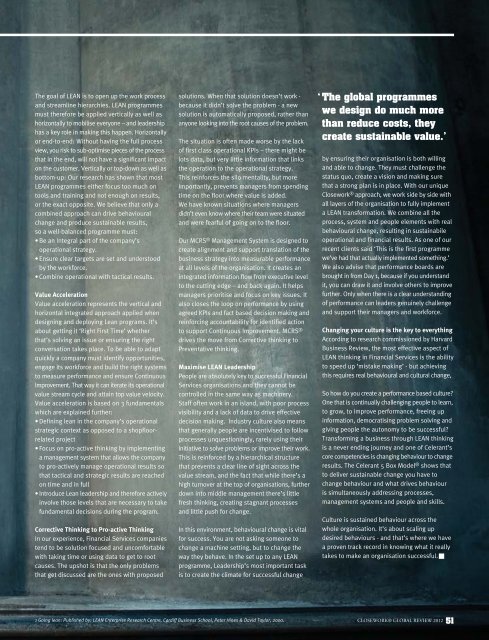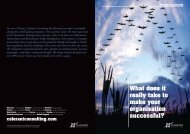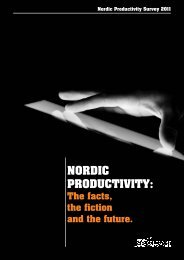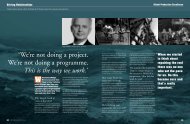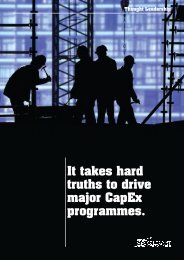download - Celerant Consulting
download - Celerant Consulting
download - Celerant Consulting
- No tags were found...
Create successful ePaper yourself
Turn your PDF publications into a flip-book with our unique Google optimized e-Paper software.
The goal of LEAN is to open up the work processand streamline hierarchies. LEAN programmesmust therefore be applied vertically as well ashorizontally to mobilise everyone – and leadershiphas a key role in making this happen. Horizontallyor end-to-end: Without having the full processview, you risk to sub-optimise pieces of the processthat in the end, will not have a significant impacton the customer. Vertically or top-down as well asbottom-up: Our research has shown that mostLEAN programmes either focus too much ontools and training and not enough on results,or the exact opposite. We believe that only acombined approach can drive behaviouralchange and produce sustainable results,so a well-balanced programme must:• Be an Integral part of the company’soperational strategy.• Ensure clear targets are set and understoodby the workforce.• Combine operational with tactical results.Value AccelerationValue acceleration represents the vertical andhorizontal integrated approach applied whendesigning and deploying Lean programs. It’sabout getting it ‘Right First Time’ whetherthat’s solving an issue or ensuring the rightconversation takes place. To be able to adaptquickly a company must identify opportunities,engage its workforce and build the right systemsto measure performance and ensure ContinuousImprovement. That way it can iterate its operationalvalue stream cycle and attain top value velocity.Value acceleration is based on 3 fundamentalswhich are explained further:• Defining lean in the company’s operationalstrategic context as opposed to a shopfloorrelatedproject• Focus on pro-active thinking by implementinga management system that allows the companyto pro-actively manage operational results sothat tactical and strategic results are reachedon time and in full• Introduce Lean leadership and therefore activelyinvolve those levels that are necessary to takefundamental decisions during the program.Corrective Thinking to Pro-active ThinkingIn our experience, Financial Services companiestend to be solution focused and uncomfortablewith taking time or using data to get to rootcauses. The upshot is that the only problemsthat get discussed are the ones with proposedsolutions. When that solution doesn’t work -because it didn’t solve the problem - a newsolution is automatically proposed, rather thananyone looking into the root causes of the problem.The situation is often made worse by the lackof first class operational KPIs – there might belots data, but very little information that linksthe operation to the operational strategy.This reinforces the silo mentality, but moreimportantly, prevents managers from spendingtime on the floor where value is added.We have known situations where managersdidn’t even know where their team were situatedand were fearful of going on to the floor.Our MCRS ® Management System is designed tocreate alignment and support translation of thebusiness strategy into measurable performanceat all levels of the organisation. It creates anintegrated information flow from executive levelto the cutting edge – and back again. It helpsmanagers prioritise and focus on key issues. Italso closes the loop on performance by usingagreed KPIs and fact based decision making andreinforcing accountability for identified actionto support Continuous Improvement. MCRS ®drives the move from Corrective thinking toPreventative thinking.Maximise LEAN LeadershipPeople are absolutely key to successful FinancialServices organisations and they cannot becontrolled in the same way as machinery.Staff often work in an island, with poor processvisibility and a lack of data to drive effectivedecision making. Industry culture also meansthat generally people are incentivised to followprocesses unquestioningly, rarely using theirinitiative to solve problems or improve their work.This is reinforced by a hierarchical structurethat prevents a clear line of sight across thevalue stream, and the fact that while there’s ahigh turnover at the top of organisations, furtherdown into middle management there’s littlefresh thinking, creating stagnant processesand little push for change.In this environment, behavioural change is vitalfor success. You are not asking someone tochange a machine setting, but to change theway they behave. In the set up to any LEANprogramme, Leadership’s most important taskis to create the climate for successful change‘ The global programmeswe design do much morethan reduce costs, theycreate sustainable value.’by ensuring their organisation is both willingand able to change. They must challenge thestatus quo, create a vision and making surethat a strong plan is in place. With our uniqueClosework ® approach, we work side by side withall layers of the organisation to fully implementa LEAN transformation. We combine all theprocess, system and people elements with realbehavioural change, resulting in sustainabileoperational and financial results. As one of ourrecent clients said ‘This is the first programmewe’ve had that actually implemented something.’We also advise that performance boards arebrought in from Day 1, because if you understandit, you can draw it and involve others to improvefurther. Only when there is a clear understandingof performance can leaders genuinely challengeand support their managers and workforce.Changing your culture is the key to everythingAccording to research commissioned by HarvardBusiness Review, the most effective aspect ofLEAN thinking in Financial Services is the abilityto speed up ‘mistake making’ - but achievingthis requires real behavioural and cultural change,So how do you create a performance based culture?One that is continually challenging people to learn,to grow, to improve performance, freeing upinformation, democratising problem solving andgiving people the autonomy to be successful?Transforming a business through LEAN thinkingis a never ending journey and one of <strong>Celerant</strong>’score competencies is changing behaviour to changeresults. The <strong>Celerant</strong> 5 Box Model ® shows thatto deliver sustainable change you have tochange behaviour and what drives behaviouris simultaneously addressing processes,management systems and people and skills.Culture is sustained behaviour across thewhole organisation. It’s about scaling updesired behaviours - and that’s where we havea proven track record in knowing what it reallytakes to make an organisation successful.1 Going lean: Published by: LEAN Enterprise Research Centre, Cardiff Business School, Peter Hines & David Taylor, 2000.CLOSEWORK® GLOBAL REVIEW 2012 51


